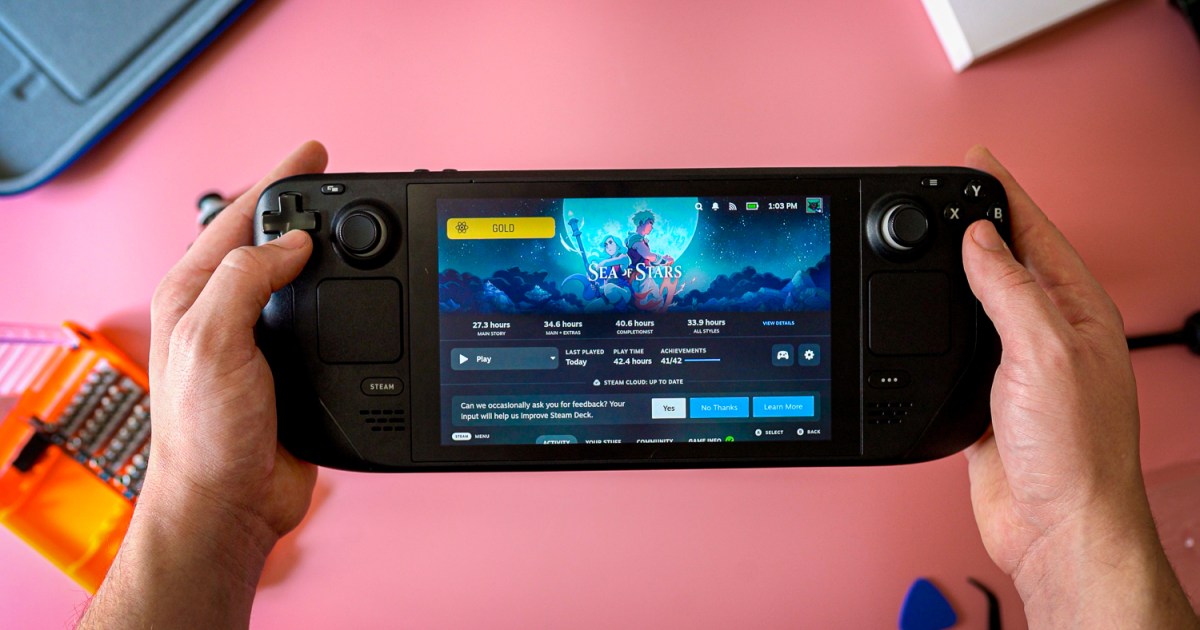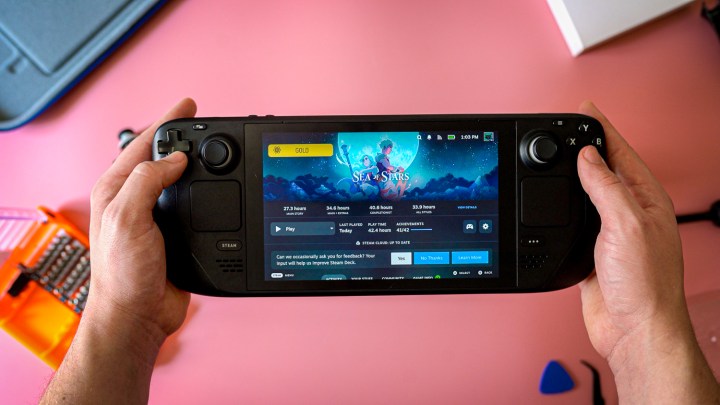 altThe Steam Deck 2 is not a question of “if,” but “when.” Valve has openly discussed their next-gen Steam Deck plans, which is unsurprising considering the original’s dominance as the best handheld gaming PC available. While a few years out, Valve has dropped hints about the upcoming handheld. This article compiles everything we currently know about the Steam Deck 2, from potential release date and specs to performance expectations.
altThe Steam Deck 2 is not a question of “if,” but “when.” Valve has openly discussed their next-gen Steam Deck plans, which is unsurprising considering the original’s dominance as the best handheld gaming PC available. While a few years out, Valve has dropped hints about the upcoming handheld. This article compiles everything we currently know about the Steam Deck 2, from potential release date and specs to performance expectations.
Steam Deck 2: Release Date Speculation
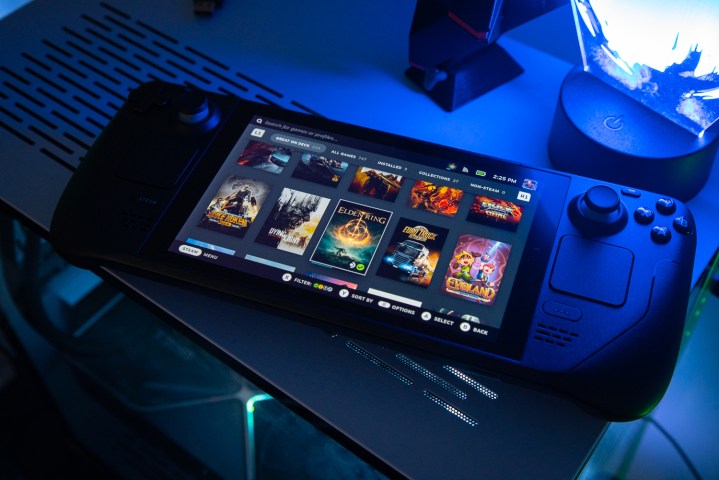 altThe Steam Deck 2 is still a few years away. In interviews with CNBC and The Verge, Valve’s Pierre-Loup Griffais emphasized a cautious approach to performance upgrades, prioritizing significant advancements without compromising battery life. He suggested such a leap isn’t likely within the next couple of years. Valve aims for a consistent gaming experience across devices, avoiding unnecessary performance target shifts for developers. A significantly more powerful chip is a prerequisite for the Steam Deck 2.
altThe Steam Deck 2 is still a few years away. In interviews with CNBC and The Verge, Valve’s Pierre-Loup Griffais emphasized a cautious approach to performance upgrades, prioritizing significant advancements without compromising battery life. He suggested such a leap isn’t likely within the next couple of years. Valve aims for a consistent gaming experience across devices, avoiding unnecessary performance target shifts for developers. A significantly more powerful chip is a prerequisite for the Steam Deck 2.
Valve’s Lawrence Yang echoed this sentiment to Rock Paper Shotgun, stating a “true next-gen Deck” with a substantial power boost is still a few years off. While the recent Steam Deck OLED upgrade demonstrates Valve’s ongoing commitment, these statements suggest a 2026 release is plausible, allowing time for a mature, significantly more powerful system-on-a-chip (SoC). Valve has reinforced this timeline, emphasizing their commitment to generational leaps in compute power while maintaining battery life, rather than incremental annual updates.
Steam Deck 2: Pricing Predictions
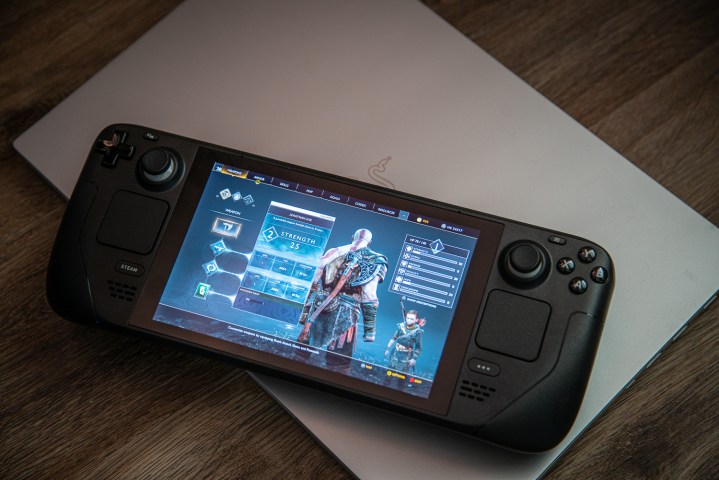 altThe Steam Deck 2’s price point is uncertain, but it’s unlikely to match the original’s $400 price tag. Valve’s Gabe Newell acknowledged the “painful” pricing of the original Steam Deck. Considering competitors like the ROG Ally and Legion Go, the current handheld gaming PC market suggests a $600-$800 range.
altThe Steam Deck 2’s price point is uncertain, but it’s unlikely to match the original’s $400 price tag. Valve’s Gabe Newell acknowledged the “painful” pricing of the original Steam Deck. Considering competitors like the ROG Ally and Legion Go, the current handheld gaming PC market suggests a $600-$800 range.
Valve acknowledges this shift, with Newell highlighting the surprising popularity of the most expensive Steam Deck SKU. The Steam Deck OLED launch further illustrates this, with newer models priced at $550 and $650, while retaining a $400 LCD version. A similar strategy is anticipated for the Steam Deck 2, potentially offering a lower-tier OLED model at $400 while positioning new versions between $500 and $700. However, market conditions could influence final pricing.
Steam Deck 2: Speculations
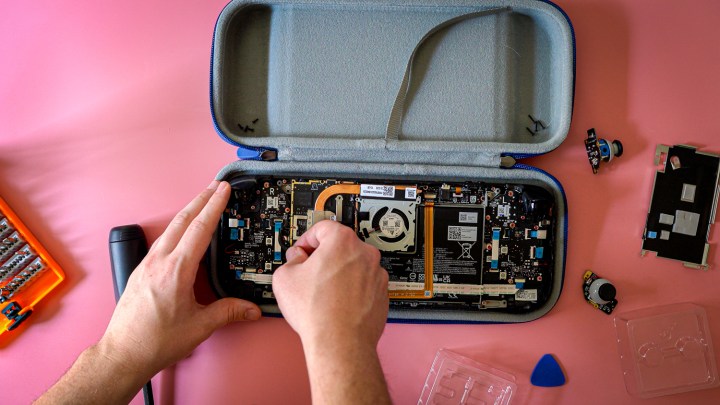 altPredicting the Steam Deck 2’s specs is challenging at this stage. Rumors suggest another custom AMD APU, potentially featuring the unreleased RDNA 4 graphics architecture and Zen 4 CPU architecture. However, this is based on online speculation and should be treated cautiously. The “Sephiroth” APU, initially speculated to be a next-gen chip, turned out to be the Steam Deck OLED’s slightly upgraded APU.
altPredicting the Steam Deck 2’s specs is challenging at this stage. Rumors suggest another custom AMD APU, potentially featuring the unreleased RDNA 4 graphics architecture and Zen 4 CPU architecture. However, this is based on online speculation and should be treated cautiously. The “Sephiroth” APU, initially speculated to be a next-gen chip, turned out to be the Steam Deck OLED’s slightly upgraded APU.
While details are scarce, AMD remains the likely choice given their strong presence in gaming devices like the PlayStation 5 and Xbox Series X. However, with Intel and potentially Nvidia entering the market, Valve’s options could broaden. Closer to launch, dedicated miners within the Linux community will likely uncover more concrete information through driver updates and commits.
Steam Deck 2: Performance Expectations
 altWhile precise performance predictions are impossible without confirmed specs, a significant performance boost over the original Steam Deck is expected, aligning with Valve’s stated goals. However, raw performance isn’t the sole focus. Balancing power efficiency and battery life, areas where the Steam Deck excels compared to competitors like the Asus ROG Ally, remains crucial.
altWhile precise performance predictions are impossible without confirmed specs, a significant performance boost over the original Steam Deck is expected, aligning with Valve’s stated goals. However, raw performance isn’t the sole focus. Balancing power efficiency and battery life, areas where the Steam Deck excels compared to competitors like the Asus ROG Ally, remains crucial.
An RDNA 4/Zen 4 APU would significantly improve ray tracing performance, a known weakness of the current RDNA 2 architecture. Even with limited ray tracing capabilities, the current Steam Deck handles some ray tracing in games like Doom Eternal. A next-gen version would likely offer substantially enhanced ray tracing capabilities.
 altSignificant advancements are also anticipated on the software front. Translation layers like DXVK, while currently stable, are still evolving. By the Steam Deck 2’s release, running Windows games on Linux should be significantly improved. Furthermore, technologies like AMD’s FSR 3, particularly its frame generation capabilities, could revolutionize performance through device-level frame interpolation.
altSignificant advancements are also anticipated on the software front. Translation layers like DXVK, while currently stable, are still evolving. By the Steam Deck 2’s release, running Windows games on Linux should be significantly improved. Furthermore, technologies like AMD’s FSR 3, particularly its frame generation capabilities, could revolutionize performance through device-level frame interpolation.
Steam Deck 2: Display Possibilities
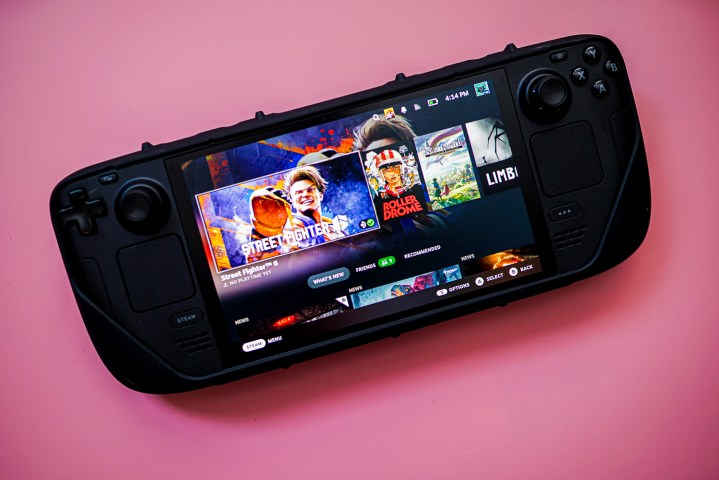 altThe Steam Deck OLED highlighted the display’s importance in handheld gaming. While rumors suggest a 900p 90Hz OLED display for the Steam Deck 2, similar to the current OLED model, a more ambitious approach is hoped for. OLED technology is likely to remain, given its transformative impact. Resolution and refresh rate increases are also expected, but will likely be balanced against the device’s overall capabilities, maintaining Valve’s focus on a cohesive and optimized experience.
altThe Steam Deck OLED highlighted the display’s importance in handheld gaming. While rumors suggest a 900p 90Hz OLED display for the Steam Deck 2, similar to the current OLED model, a more ambitious approach is hoped for. OLED technology is likely to remain, given its transformative impact. Resolution and refresh rate increases are also expected, but will likely be balanced against the device’s overall capabilities, maintaining Valve’s focus on a cohesive and optimized experience.



